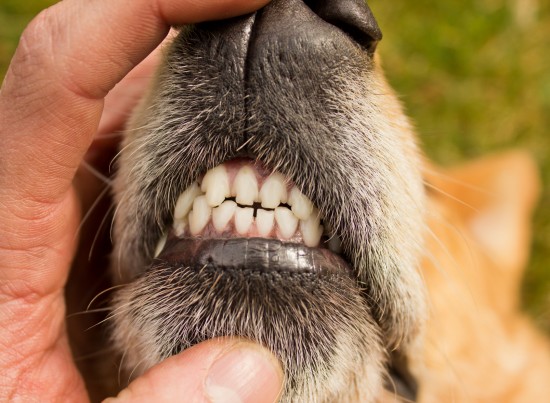

We've learned already that corn, an ingredient used in most commercial dog food, is something that many dogs are allergic to. It's important to remember that a dog can develop an allergy to almost anything that they are exposed to over time, but some dogs seem to have been born with allergies.
Another important distinction to make is whether or not your dog has a food allergy or a food intolerance. An allergy is best diagnosed by the classic allergy symptoms: sneezing, wheezing, runny eyes, nose, itchy skin, especially on the face, feet, ears, armpits, crotch and anus. Recurring ear infections or stinky ears are other tell-tale signs. So are rashes and hot spots. A hot spot is just what it sounds like, a place on your dog's skin that has been scratched, bitten and irritated so much that the skin is raw and warmer to the touch than the surrounding area.
A food intolerance is characterized by digestion problems. Throwing up, diarrhea and if left on the same diet for too long, weight loss. And yes, your dog can initially be allergic to an ingredient and develop an intolerance.
To further complicate things, corn isn't the only ingredient in commercial dog food that dogs are prone to have problems with. Some of the other common ingredients include: wheat, yeast, dairy, eggs and soy. Check the dog food in your pantry right now. If corn is the number #1 ingredient, which means the bulk of the food is made from that ingredient, or the other allergens I just listed are in the first 10 ingredients, your dog food could be making your dog sick.
You'll also hear occasionally that a dog can be allergic to a protein source, chicken, beef, etc. However, these are generally not a true allergy but a developed intolerance due to the processing, chemicals or additives in the protein source.
Whew! That was a lot, right? Hold on, we're not done yet!
Dogs can develop allergies or an intolerance to things introduced into their atmosphere. Here's a perfect example: When Heidi, my German Shepherd, was a puppy, she had a habit of licking and biting her crotch, literally for hours. This was above and beyond normal dog crotch-licking, to the point that I discovered she had dark marks in the area and the skin was raw. One vet gave her a cream for her skin, another a spray that tasted bad to help Heidi stop chewing herself. Another prescribed her an ointment because she had a staph infection. Come to find out that dogs have a natural type of staphylococcus on them but they sometimes develop a sensitivity to it. What finally worked for Heidi was a natural cure. By introducing acidophilus into her system, the good bacteria helped counteract the other bacteria in her system. Problem solved - finally.
What makes this example sad to me at this point is that Heidi's good bacteria was probably wiped out by all the antibiotics she had received. This is one of the reasons why I'm so passionate about working with my dogs the natural way.
Other non food related things that can cause allergic reactions are atophy, flea bite allergies and intestinal parasite hypersensitivities. I know what you're thinking - flea bite allergies? Don't all dogs scratch when they have fleas? However a dog with a flea bite allergy can have a reaction to the bite long after the flea is gone.
Dogs also can have or develop inhalant allergies, meaning pollen and dust.
One way to tell if your dog is dealing with allergies is if your very young dog has always had moderate to severe skin problems. Another sign is a dog with no allergy symptoms usually has an average of 1.5 bowel movements a day. A dog with allergies will have an average of 3 or more per day.
So let's say that you now know that your dog is suffering from an allergy to something, what do you do now? Is there a way to help your dog naturally, without steroids, creams or pills? How do you find out what your dog is allergic to?
The easiest and most thorough way to start determining what the root cause is would be by performing a food trial. A food trial is when you pick one protein source and one carbohydrate source that you will feed your dog for 12 weeks.
Good combinations would include: chicken breast and potatoes, turkey and rice (I would recommend a combination of brown and white rice) or fish and sweet potatoes. Pick something that will be convenient for you to prepare for the next 3 months. Previously, food trials for allergies were only held for 3 weeks, however not all allergies will surface in the first 21 days. The longer trial gives you enough time to completely confirm or discard a food from the list.
The key is being consistent. This is the only 2 ingredients they will have in their diet for 12 weeks; no medications, no treats, no pig ears, etc.
If all of your dog's symptoms have subsided in 3 months, you can start then gradually adding one ingredient at a time. Pay close attention to the reaction as well as other things your dog comes into contact with during this period of time. If you introduced eggs the same day your dog went to the beach, you can't assume their scratching that day is strictly food related.
My German Shepherd became a new dog after 12 weeks of hamburger meat and rice patties. These were easy and cheap to make, I could freeze them in patties and thaw them as needed. Heidi went from underweight, dull fur and dandruff, really a miserable mess to a healthy weight, shiny fur, much happier dog; something I might add that nothing I had gotten from vets had given her. It's a little time consuming but they are worth it.
Finally, something to keep in mind is that allergies are auto-immune diseases so the way to avoid all allergies are to naturally boost and strengthen your dog's auto-immune system. We will look at natural, easy ways that you can do this from home in Part 3.
 10 Most Expensive Dog Breeds To Own
10 Most Expensive
10 Most Expensive Dog Breeds To Own
10 Most Expensive
 Rabbit Agility - Teaching Your Rabbit Tricks
Rabbit Agility -
Rabbit Agility - Teaching Your Rabbit Tricks
Rabbit Agility -
 Helpful Tips And Advice About Adopting A Rescue Dog
Helpful Tips And
Helpful Tips And Advice About Adopting A Rescue Dog
Helpful Tips And
 Some Home Dental Care Tips & Tricks For Dogs
Some Home Dental
Some Home Dental Care Tips & Tricks For Dogs
Some Home Dental
 Benefits Of Big Bags Of Salmon Meal For Your Dog
Benefits Of Big Bags Of Salmon Meal For Your Dog
Benefits Of Big Bags Of Salmon Meal For Your Dog
Benefits Of Big Bags Of Salmon Meal For Your Dog
Copyright © 2005-2016 Pet Information All Rights Reserved
Contact us: www162date@outlook.com